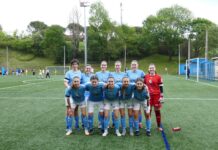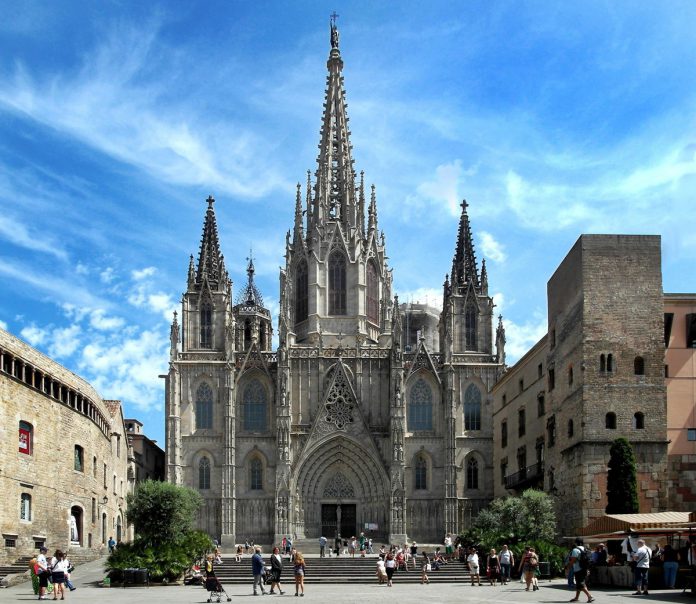The Cathedral of Barcelona, also known as the Cathedral of the Holy Cross and Saint Eulalia, is a famous landmark in the heart of the Gothic Quarter in Barcelona, Spain. With its stunning Gothic architecture and rich history, the cathedral is a must-see attraction for visitors to Barcelona.
The construction of the cathedral began in the 13th century, in the same location where the former Romanesque cathedral stood. It took nearly 150 years to complete the Gothic masterpiece, with the final touches added in the 15th century. The cathedral’s façade was designed by a famous Spanish architect, Antoni Gaudí, who also designed other famous landmarks in Barcelona, such as the Park Güell and the Sagrada Familia.
The cathedral is dedicated to Saint Eulalia, the patron saint of Barcelona, who was martyred during the Roman Empire’s persecution of Christians. The cathedral houses her tomb, which is located in the crypt below the high altar. The cathedral’s other notable features include the choir stalls, which are adorned with intricate carvings depicting scenes from the Bible, and the cloister, which is a peaceful oasis in the heart of the bustling city.
The cathedral’s interior is impressive, with soaring Gothic arches, stained glass windows, and intricate sculptures and History of Barcelona Cathedral. The cathedral’s central nave is flanked by side chapels, each with its unique artwork and architectural features. Visitors can also climb the cathedral’s bell tower for a breathtaking view of the city.
The cathedral has played a significant role in Barcelona’s history. During the Spanish Civil War, the cathedral served as a shelter for civilians, and its crypt served as a morgue. The cathedral was also the site of several important religious events, such as the coronation of King Ferdinand II of Aragon and Queen Isabella I of Castile in 1496.
Today, the cathedral is an active place of worship and a popular tourist destination. Visitors can attend mass and other religious services, explore the cathedral’s rich history and architecture, and even attend concerts and cultural events held in the cathedral’s nave.
In conclusion, the Cathedral of Barcelona is a must-see attraction for anyone visiting Barcelona. Its stunning Gothic architecture, rich history, and religious significance make it a significant landmark in the city. From its intricate carvings to its soaring arches, the cathedral is a testament to the skill and creativity of the architects and artisans who built it. Whether you are a history buff, an architecture enthusiast, or a spiritual seeker, the Cathedral of Barcelona is sure to leave a lasting impression on you.
Apart from the cathedral’s impressive architecture and rich history, there are many other interesting facts about the Cathedral of Barcelona that make it a unique and fascinating attraction.
One such fact is the legend of Saint Eulalia, the patron saint of Barcelona. According to legend, Saint Eulalia was just 13 years old when she was martyred during the Roman Empire’s persecution of Christians. Her body was then subjected to various tortures, including being placed in a barrel filled with knives and rolled down a hill. Today, visitors can see a statue of Saint Eulalia in the cathedral’s cloister, which depicts her holding a palm branch and a book.
Another interesting fact about the cathedral is its bell tower, which stands at a height of 69 meters. Visitors can climb the tower’s spiral staircase to reach the top, where they will be rewarded with a stunning view of the city. The bell tower also houses the cathedral’s 17th-century bell, which weighs more than 3,000 kilograms.
The cathedral’s cloister is another highlight of the visit, with its peaceful garden and tranquil fountain. The cloister was built in the 14th century and is home to a flock of geese, which are said to represent Saint Eulalia’s age at the time of her martyrdom.
The cathedral’s choir stalls are also worth a visit, with their intricate carvings depicting scenes from the Bible and the lives of the saints. The choir stalls were crafted by a team of skilled artisans over a period of several decades in the 15th century.
In addition to its religious significance, the cathedral has also played a significant role in Barcelona’s cultural and artistic life. The cathedral’s nave has hosted numerous concerts and cultural events over the years, attracting both local and international artists and performers.
In conclusion, the Cathedral of Barcelona is a true gem of the city, with its stunning Gothic architecture, rich history, and religious significance. Its bell tower, cloister, choir stalls, and other unique features make it a must-see attraction for visitors to Barcelona. Whether you are interested in history, architecture, art, or spirituality, the Cathedral of Barcelona is sure to leave a lasting impression on you.





























